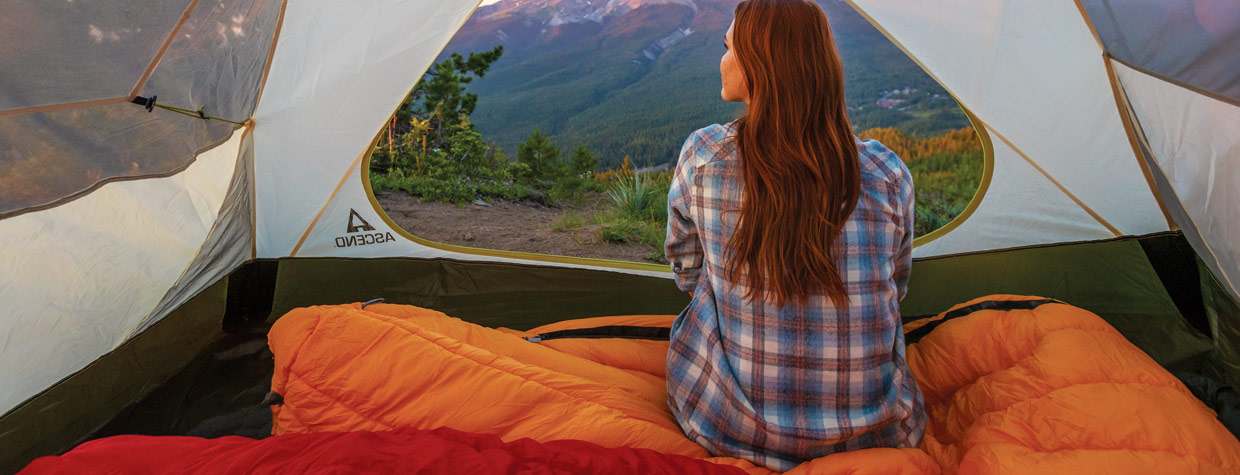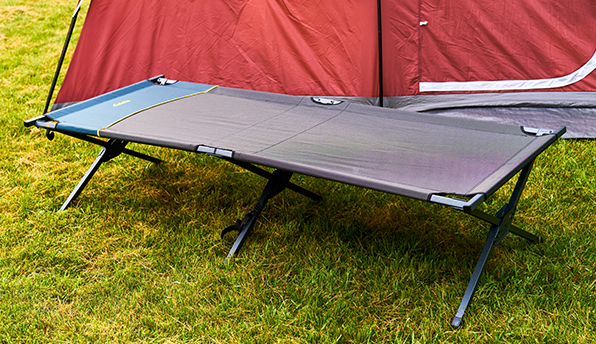Sleeping Bags

How to choose a sleeping bag for camping
When it comes to choosing a comfortable sleeping bag for your adventures, consider temperature rating, shape, material, type of sleeping bag and the weight. This will help narrow down your choices to pick the right one.

Temperature Rating in Sleeping Bags
Sleeping bag manufacturers use two types of rating methods.
Comfort Rating: This indicates the temperature at which a cold sleeper might feel comfortable.
Lower Limit Rating: This temperature is always lower than the comfort rating at which a warm sleeper might feel comfortable.
The temperature ratings are only an estimate. Sleeping bags are tested in a lab-controlled environment and do not consider variations in people’s clothing, body temperatures, gear, changing weather conditions, etc. A -18°C sleeping bag can only keep you warm when paired with base layers and an appropriately rated sleeping pad.

Material
Synthetic: Synthetic sleeping bags contain manufactured insulation such as poly-fibres. Despite being affordable, they are easy to maintain and suitable for damp/wet conditions. These bags are perfect for casual campers tenting in muddy/wet conditions.
Down: Down sleeping bags are filled with high-quality duck or goose feathers to retain body heat. While these bags are lighter, longer-lasting, easier to compress and pack, they require extra effort to clean. Aside from wet conditions, these bags are great for most situations.
Shape
Sleeping bags come in several different shapes and configurations. The most common shape is rectangular, designed for maximum roominess. Two bags with compatible zippers can also be linked together to create a double sleeping bag. Double-sized sleeping bags are ideal for couples or families.
Semi-rectangular sleeping bags are also a popular choice, and feature a slightly rounded top. Mummy sleeping bags feature a narrow toe that gradually widens at the hip and shoulder. These are the snuggest, lightest sleeping bags and are designed to maximize warmth.
Features
Consider the following features when purchasing a sleeping bag:
- Sleeping bag hood, for more heat in cool conditions
- Extra pockets, to keep your phone, flashlight, glasses or portable music player close
- Sleeping pad sleeve, to prevent rolling off a sleeping pad in the night
- Pillow pocket, for stuffing with clothing or soft items to create a pillow
- Extra liner, for increased warmth in winter weather
Backpacking Sleeping Bags
Make trekking through nature easy with a sleeping bag that suits your with a sleeping bag that suits your needs.
Backpacking sleeping bags are efficient, warm, lightweight and comfortable. These bags are highly compressible, so they won't get in the way as you hike through a rugged terrain.
Outfitter Sleeping Bags
Robust and durable, roomy and warm, Cabela’s Outfitter sleeping bags keep nature from disturbing a good night’s sleep. Featuring cozy cotton flannel and over 4 lbs. of hollow fibre insulation, Outfitter sleeping bags are a great way to keep you warm when camping out in the Canadian cold.

Camping should be a cozy and comfortable experience. Having the right sleeping bag can help ensure you feel snug and sleep tight.
How to Care for Your Sleeping Bag
Be it synthetic or down, keep your sleeping bag clean as you camp. Taking proper care of your sleeping bag means you can look forward to a cozy and restful good night’s sleep.
Learn how to clean, wash, dry and store your sleeping bag like an expert.

SLEEPING PADS

When choosing a sleeping pad, consider the weight, insulation and comfort.
There are generally three different types of sleeping pads:
Air pads: Very lightweight and portable. A favourite among backpacking campers, though can be prone to punctures from stones or sticks. These can often easily be fixed with the pads’ repair patch kit.
Self-inflating pads: A great middle-of-the-road option, boasting portability while not being too bulky. These pads are better suited for side sleepers, as it will give more padding for your hips. These may also be prone to punctures, but can easily be fixed with a repair patch kit which is often included.
Foam pads: Lightweight and durable, but more bulky than air and self-inflating pads. Usually the most economical option. When looking for insulation, check the pads’ R-value. The higher the R-value, the more insulated.
Cots

Cots are great for those who don’t have to carry their gear for long before setting up camp.
They offer increased support, while maximizing storage space in your tent by allowing you to store gear underneath it. A few things to consider when looking for a cot:
Weight: You’ll want to consider how far you’ll be travelling with the cot in tow before setting up camp. Opt for an ultralight model if you will be going a distance.
Size & capacity: Make sure you fit comfortably on your cot. Cots will have varying weight limits, and come in different sizes, just like campers themselves.
Ease of assembly: If you are moving your camp every night, having a cot that easily assembles and dissembles will be crucial. If you are staying in one place for a while, you can get away with one that may take more time to assemble at the beginning.